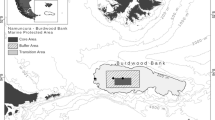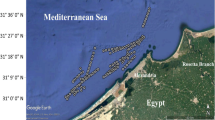Abstract
The circumboreal sea anemone species Metridium senile is a non-native species in Chilean Patagonia. The species is responsible for the occupation of large tracts of benthic substrate, threatening benthic resources such as sea urchins and barnacles. It has potentially devastating ecological impact on the overall benthic community. Species associated to the genus Metridium have been alluded to in the historical literature on Chilean marine life by various names. We summarize and evaluate their appearance in the literature and suggest eliminating the name Metridium senile lobatum for the South American subspecies. The first appearance of Metridium senile was confirmed in 2005 by the authors from Central Patagonia. Subsequently it was noted as abundant at multiple sites. In North Patagonia, it was first recorded from one site in 2011, followed by one more record in 2013 and several in 2015. In subsequent years, it has been recorded at an increasing number of sites based on our surveying. During our most recent surveys in 2021, we confirmed that it remains abundant at numerous sites throughout North Patagonia. In South Patagonia, it was first reported in 2015 from one site in the Straits of Magellan, and from two further sites around Cape Horn in 2017. It has not been recorded at additional sites nor has it significantly increased in abundance in southern Chilean Patagonia. However, it has been observed to be common at the Becasses Islands in the Argentinean part of Beagle Channel in 2021. Therefore, we recommend starting a monitoring program and putting restrictions on the transport of benthic invertebrates to avoid introducing the species to sites where it is not present yet.



Similar content being viewed by others
Data availability
I hereby confirm that the data used to produce this article are added as supplementary data.
References
Barbier EB (2017) Marine ecosystem services. Curr Biol 27(11):R507–R510. https://doi.org/10.1016/j.cub.2017.03.020
Betti F, Enrichetti F, Bavestrello G, Costa A, Moreni A, Bo M, Ortiz Saini P and Daneri G (2021) Hard-bottom megabenthic communities of a Chilean fjord system: sentinels for climate change? Front Mar Sci 8:635430. https://doi.org/10.3389/fmars.2021.635430
Camus PA (2001) Biogeografía marina de Chile continental. Rev Chil Hist Nat 74(3):587–617
Carlgren O (1898) Zoantharien. Hamb Magalh Sammelr 4:1–48
Carlton JT, Geller JB (1993) Ecological roulette: the global transport of nonindigenous marine organisms. Science 261(5117):78–82
Försterra G (2009) Ecological and biogeographical aspects of the chilean fjord region. In: Häussermann V, Försterra G (eds) Marine benthic fauna of Chilean Patagonia. Nature in Focus, Puerto Montt, pp 61–76
Försterra G, Häussermann V, Laudien J (2017) Animal forests in the Chilean fiords: Discoveries, perspectives and threats in shallow and deep waters. In: Rossi S, Bramanti L, Gori A, Orejas C (eds) Marine Animal Forests. The ecology of benthic biodiversity hotspots Vol I, pp 277–313. https://doi.org/10.1007/978-3-319-17001-5_3-1
Glon H, Haruka Y, Daly M, Nakaoka M (2019) Temperature and salinity survival limits of the fluffy sea anemone, Metridium senile (L.), Japan. Hydrobiol 830(1):303–315
Glon H, Daly M, Carlton JT, Flenniken MM, Currimjee Z (2020) Mediators of invasions in the sea: life history strategies and dispersal vectors facilitating global sea anemone introductions. Biol Invasions 16:1–28. https://doi.org/10.1007/s10530-020-02321-6
Glon HE, Costa M, de Lecea AM, Goodwin C, Cartwright S, Díaz A, Brickle P, Brewin PE (2020b) First record of the plumose sea anemone, Metridium senile (Linnaeus, 1761), from the Falkland Islands. BioInvasion Records 9(3):461–470
Häussermann V (2006) Biodiversity of Chilean sea anemones (Cnidaria: Anthozoa): distribution patterns and biogeographic implications; including new records for the fjord region. Invest Mar (Valparaiso) 34(2):23–35
Häussermann V, Försterra G (eds) (2009) Marine benthic fauna of Chilean Patagonia. Nature in Focus, Puerto Montt, pp 1000
Häussermann V, Försterra G, Melzer RR, Meyer R (2013) Gradual changes of benthic biodiversity in Comau fjord, Chilean Patagonia–lateral observations over a decade of taxonomic research. Spixiana 36(2):161–171
Häussermann V, Spano C, Thiel M, Lohrmann K (2015) First record of the sea anemone Diadumene lineata (Verrill, 1869) (Cnidaria: Anthozoa: Actiniaria) from the Chilean coast. Spixiana 38(1):39–42
Häussermann V, Försterra G, Laudien J (2021a) Macrobentos de fondos duros de la Patagonia chilena: énfasis en la conservación de bosques sublitorales de invertebrados y algas. In: Castilla JC, Armesto JJ, Martínez-Harms MJ (eds) Conservación en la Patagonia Chilena: evaluación del conocimiento, oportunidades y desafíos. Ediciones Universidad Católica, Santiago, Chile, pp 321–344
Häussermann V, Ballyram S, Försterra G, Cornejo C, Ibáñez CM, Sellanes J, Thomasberger A, Espinoza JP, Beaujot F (2021) Species that fly at a higher game: patterns of deep–water emergence along the Chilean coast, including a global review of the phenomenon. Front Mar Sci 8:688316. https://doi.org/10.3389/fmars.2021b.688316
iNaturalist. Available from https://www.inaturalist.org. Accessed [November 4, 2021]
Ma KCK, Glon HE, Hawk HL, Chapman CN (2020) Reconstructing the distribution of the non-native sea anemone, Diadumene lineata (Actiniaria), in the Canadian Maritimes: local extinction in New Brunswick and no regional range expansion in Nova Scotia since its initial detection. Reg Stud Mar Sc 34:101049
Mardones JI, Paredes J, Godoy M, Suarez R, Norambuena L, Vargas V, Fuenzalida G, Pinilla E, Artal O, Rojas X, Dorantes-Aranda JJ, Lee Chang KJ, Anderson DM, Hallegraeff GM (2021) Disentangling the environmental processes responsible for the world’s largest farmed fish-killing harmful algal bloom: Chile, 2016. Sci Total Environ 20(766):144383. https://doi.org/10.1016/j.scitotenv.2020.144383
Martin JP, Garese A, Sar A, Acuña FH (2015) Fouling community dominated by Metridium senile (Cnidaria: Anthozoa: Actiniaria) in Bahía San Julián (southern Patagonia, Argentina). Sci Mar 79(2):211–221. https://doi.org/10.3989/scimar.004082.21A
McMurrich JP (1904) The Actiniae of the Plate collection. Zool Jahrb 6Suppl(2):215–306
Molinet C, Barahona N, Espinoza O, Guzmán L (2021) Reporte de expansión de Metridium sp. en sector Canal Chacao, pp 10
Morandini A, Stampar S, Maronna M, Da Silveira F (2017) All non-indigenous species were introduced recently? The case study of Cassiopea (Cnidaria: Scyphozoa) in Brazilian waters. J Mar Biol Ass UK 97(2):321–328. https://doi.org/10.1017/S0025315416000400
Riemann-Zürneck K (1975) Actiniaria des Südwestatlantik („ Actiniaria of the southwest Atlantic Ocean"). Helgol Wiss Meeresunters 27:70–95. https://doi.org/10.1007/BF01611687
Riemann-Zürneck K (1986) Zur Biogeographie des Südwestatlantik mit besonderer Berücksichtigung der Seeanemonen (Coelenterata: Actiniaria) („On the biogeography of the southwest Atlantic Ocean with special reference to sea anemones (Coelenterata: Actiniaria)”. Helgol Wiss Meeresunters 40:91–149. https://doi.org/10.1007/BF01987291
Stampar S, Gamero-Mora E, Maronna M, Fritscher J, Oliveira B, Sampaio C, Morandini A (2020) The puzzling occurrence of the upside-down jellyfish Cassiopea (Cnidaria: Scyphozoa) along the Brazilian coast: a result of several invasion events? Zoologia (Curitiba) 37:1–10. https://doi.org/10.3897/zoologia.37.e50834
Stephenson TA (1935) The British sea anemones, vol 2. Ray Society, London
Velasco-Charpentier C, Pizarro-Mora F, Navarro NP, Valdivia N (2021) Disentangling the links between habitat complexity and biodiversity in a kelp-dominated subantarctic community. Ecol Evol 11:1214–1224. https://doi.org/10.1002/ece3.7100
Wahl M (1985) The recolonization potential of Metridium senile in an area previously depopulated by oxygen deficiency. Oecologia 67:255–259. https://doi.org/10.1007/BF00384295
Funding
The data collection was financed by Fondecyt projects nr 1131039, 1150843, 1161699 and 1201717 to VH and GF, the FIP project 2012–14 "Diseño e implementación de una red de estaciones fijas de monitoreo para la pesquería del recurso erizo de la X y XI Regiones" to CM and the project financed by Ministerio de Economía y Turismo "Seguimiento de Pesquerías Bentónicas” to IFOP (project number 20/2020 from decree MINECOM N° 85).
Author information
Authors and Affiliations
Contributions
VH and CM: designed the study. All authors contributed to data collection and analysis. The first draft of the manuscript was written by Verena Häussermann and all authors commented on previous versions of the manuscript. All authors read and approved the final manuscript.
Corresponding author
Ethics declarations
Conflict of interest
The authors have no relevant financial or non-financial interests to disclose.
Additional information
Publisher's Note
Springer Nature remains neutral with regard to jurisdictional claims in published maps and institutional affiliations.
Supplementary Information
Below is the link to the electronic supplementary material.
10530_2022_2878_MOESM1_ESM.xls
Tab 1: Presence and absence registers of Metridium senile throughout Chilean Patagonia, sorted by site and date. (XLS 257 KB)
Rights and permissions
About this article
Cite this article
Häussermann, V., Molinet, C., Díaz Gómez, M. et al. Recent massive invasions of the circumboreal sea anemone Metridium senile in North and South Patagonia. Biol Invasions 24, 3665–3674 (2022). https://doi.org/10.1007/s10530-022-02878-4
Received:
Accepted:
Published:
Issue Date:
DOI: https://doi.org/10.1007/s10530-022-02878-4




